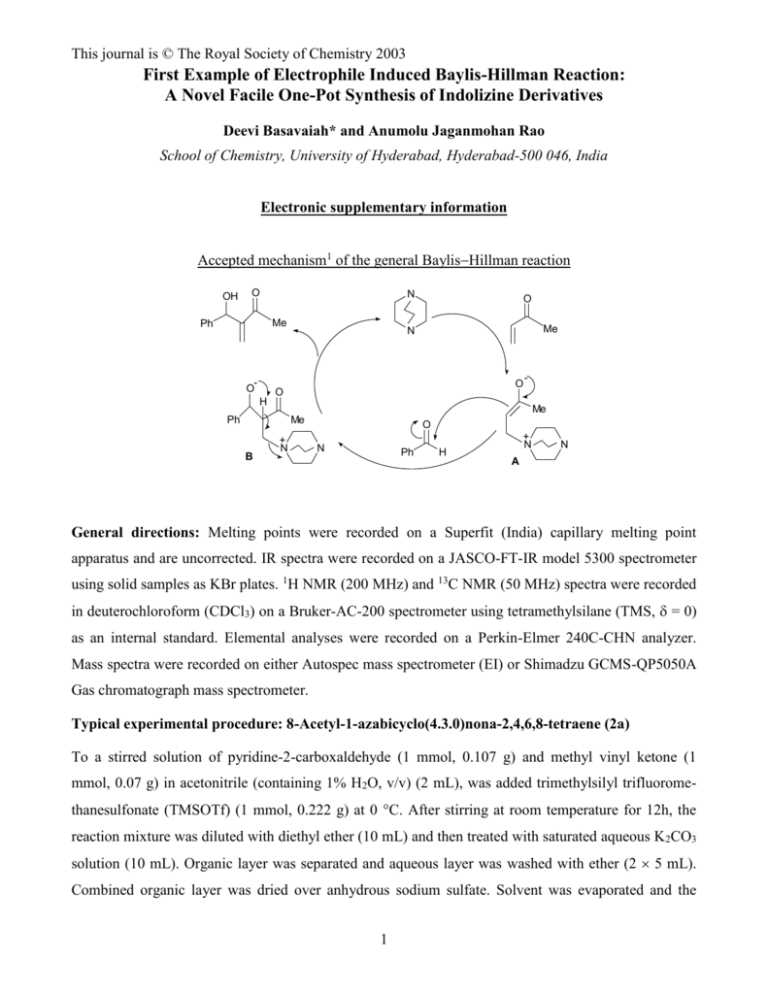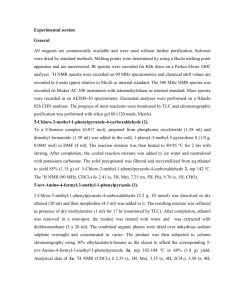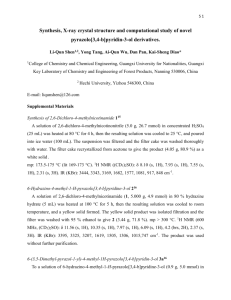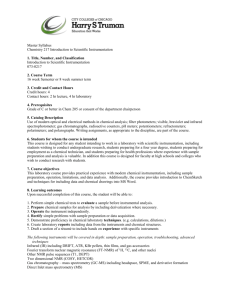The First Example of Electrophile Induced Intra Molecular Baylis
advertisement

This journal is © The Royal Society of Chemistry 2003 First Example of Electrophile Induced Baylis-Hillman Reaction: A Novel Facile One-Pot Synthesis of Indolizine Derivatives Deevi Basavaiah* and Anumolu Jaganmohan Rao School of Chemistry, University of Hyderabad, Hyderabad-500 046, India Electronic supplementary information Accepted mechanism1 of the general BaylisHillman reaction OH O N Me Ph O H Me N O O Me Ph Me B O + N O N Ph H + N N A General directions: Melting points were recorded on a Superfit (India) capillary melting point apparatus and are uncorrected. IR spectra were recorded on a JASCO-FT-IR model 5300 spectrometer using solid samples as KBr plates. 1H NMR (200 MHz) and 13C NMR (50 MHz) spectra were recorded in deuterochloroform (CDCl3) on a Bruker-AC-200 spectrometer using tetramethylsilane (TMS, = 0) as an internal standard. Elemental analyses were recorded on a Perkin-Elmer 240C-CHN analyzer. Mass spectra were recorded on either Autospec mass spectrometer (EI) or Shimadzu GCMS-QP5050A Gas chromatograph mass spectrometer. Typical experimental procedure: 8-Acetyl-1-azabicyclo(4.3.0)nona-2,4,6,8-tetraene (2a) To a stirred solution of pyridine-2-carboxaldehyde (1 mmol, 0.107 g) and methyl vinyl ketone (1 mmol, 0.07 g) in acetonitrile (containing 1% H2O, v/v) (2 mL), was added trimethylsilyl trifluoromethanesulfonate (TMSOTf) (1 mmol, 0.222 g) at 0 C. After stirring at room temperature for 12h, the reaction mixture was diluted with diethyl ether (10 mL) and then treated with saturated aqueous K 2CO3 solution (10 mL). Organic layer was separated and aqueous layer was washed with ether (2 5 mL). Combined organic layer was dried over anhydrous sodium sulfate. Solvent was evaporated and the 1 This journal is © The Royal Society of Chemistry 2003 crude product was purified by column chromatography (silica gel, 5% EtOAc in hexanes) to furnish the title molecule (2a) in 38% (0.06 g) yield as a colorless solid. M.p.: 118-120 C (lit.9 127 oC) IR (KBr): 1664 cm 1 2.54 (s, 3H), 6.48-6.62 (m, 1H), 6.64-6.75 (m, 1H), 6.78 (s, 1H), H NMR: O -1 N 7.35 (d, 1H, J = 9.0 Hz), 7.77 (s, 1H), 7.86 (d, 1H, J = 6.9 Hz) 13 C NMR: 27.64, 99.56, 112.64, 115.24, 118.47, 120.56, 125.54, 128.57, 133.18, 195.06 GCMS (m/z): 159 (M+) Anal. calcd. for C10H9NO: C, 75.45; H, 5.70; N, 8.80 Found: C, 75.26; H, 5.71; N, 8.75 8-(1-Oxoprop-1-yl)-1-azabicyclo(4.3.0)nona-2,4,6,8-tetraene (2b) Yield: 51% M.p.: 102-104 C IR (KBr): 1670 cm-1 1 1.23 (t, 3H, J = 7.8 Hz), 2.94 (q, 2H, J = 7.8 Hz), 6.48-6.61 (m, H NMR: O N 1H), 6.63-6.76 (m, 1H), 6.79 (s, 1H), 7.36 (d, 1H, J = 9.0 Hz), 7.78 (s, 1H), 7.86 (d, 1H, J = 6.8 Hz) 13 C NMR: 8.43, 33.02, 99.10, 112.36, 114.80, 118.25, 120.32, 125.44, 127.94, 132.97, 197.93 Anal. calcd. for C11H11NO: C, 76.28; H, 6.40; N, 8.09 Found: C, 76.37; H, 6.36; N, 8.12 8-(1-Oxobut-1-yl)-1-azabicyclo(4.3.0)nona-2,4,6,8-tetraene (2c) Yield: 50% M.p.: 76 C IR (KBr): 1666 cm 1 1.00 (t, 3H, J = 7.0 Hz), 1.65-1.91 (m, 2H), 2.87 (t, 2H, J = H NMR: O -1 N 7.0 Hz), 6.47-6.59 (m, 1H), 6.64-6.75 (m, 1H), 6.79 (s, 1H), 7.35 (d, 1H, J = 9.0 Hz), 7.77 (s, 1H), 7.85 (d, 1H, J = 6.7 Hz) 13 C NMR: 13.87, 18.15, 41.93, 99.22, 112.39, 114.93, 118.27, 120.36, 125.46, 128.31, 133.01, 197.52 EIMS (m/z): 187 (M+) 2 This journal is © The Royal Society of Chemistry 2003 Anal. calcd. for C12H13NO: C, 76.98; H, 7.00; N, 7.48 Found: C, 76.83; H, 7.05; N, 7.52 8-(1-Oxopent-1-yl)-1-azabicyclo(4.3.0)nona-2,4,6,8-tetraene (2d) Yield: 45 % M.p.: 80-81 C IR (KBr): 1664 cm-1 1 0.95 (t, 3H, J = 7.2 Hz), 1.29-1.54 (m, 2H), 1.65-1.87 (m, 2H), 2.88 (t, 2H, J = 7.5 H NMR: O N Hz), 6.48-6.60 (m, 1H), 6.62-6.73 (m, 1H), 6.79 (s, 1H), 7.36 (d, 1H, J = 9.0 Hz), 7.77 (s, 1H), 7.85 (d, 1H, J = 6.8 Hz) 13 C NMR: 13.91, 22.57, 26.96, 39.85, 99.36, 112.48, 114.96, 118.32, 120.49, 125.51, 128.39, 133.10, 197.75 Anal. calcd. for C13H15NO: C, 77.58; H, 7.51; N, 6.96 Found: C, 77.84; H, 7.49; N, 6.93 8-(1-Oxohex-1-yl)-1-azabicyclo(4.3.0)nona-2,4,6,8-tetraene (2e) Yield: 55% M.p.: 85-86 C IR (KBr): 1666 cm 1 0.90 (t, 3H, J = 6.8 Hz), 1.19-1.52 (m, 4H), 1.61-1.90 (m, 2H), 2.87 (t, 2H, J = 7.2 H NMR: O N -1 Hz), 6.47-6.61 (m, 1H), 6.62-6.75 (m, 1H), 6.78 (s, 1H), 7.35 (d, 1H, J = 9.0 Hz), 7.76 (s, 1H), 7.85 (d, 1H, J = 7.1 Hz) 13 C NMR: 13.87, 22.47, 24.46, 31.58, 40.01, 99.24, 112.40, 114.92, 118.27, 120.37, 125.45, 128.28, 133.01, 197.70 EIMS (m/z): 215 (M+) Anal. calcd. for C14H17NO: C, 78.10; H, 7.96; N, 6.51 Found: C, 78.05; H, 8.00; N, 6.55 8-(1-Oxohept-1-yl)-1-azabicyclo(4.3.0)nona-2,4,6,8-tetraene (2f) Yield: 44% M.p.: 88 C IR (KBr): 1664 cm O N -1 3 This journal is © The Royal Society of Chemistry 2003 1 H NMR: 0.89 (t, 3H, J = 6.6 Hz), 1.16-1.50 (m, 6H), 1.66-1.90 (m, 2H), 2.88 (t, 2H, J = 7.1 Hz), 6.48-6.61 (m, 1H), 6.63-6.76 (m, 1H), 6.79 (s, 1H), 7.36 (d, 1H, J = 9.0 Hz), 7.77 (s, 1H), 7.86 (d, 1H, J = 6.8 Hz) 13 C NMR: 13.96, 22.48, 24.78, 29.10, 31.66, 40.11, 99.32, 112.42, 114.94, 118.28, 120.43, 125.48, 128.38, 133.08, 197.67 GCMS (m/z): 229 (M+) Anal. calcd. for C15H19NO: C, 78.56; H, 8.35; N, 6.11 Found: C, 78.35; H, 8.38; N, 6.09 8-(1-Oxooct-1-yl)-1-azabicyclo(4.3.0)nona-2,4,6,8-tetraene (2g) Yield: 43% M.p.: 90-91 C IR (KBr): 1664 cm-1 1 0.88 (t, 3H, J = 6.6 Hz), 1.15-1.52 (m, 8H), 1.64-1.88 (m, 2H), 2.88 (t, 2H, J = 7.0 H NMR: O N Hz), 6.48-6.61 (m, 1H), 6.63-6.76 (m, 1H), 6.79 (s, 1H), 7.36 (d, 1H, J = 9.0 Hz), 7.77 (s, 1H), 7.85 (d, 1H, J = 6.5 Hz) 13 C NMR: 14.08, 22.66, 24.92, 29.19, 29.49, 31.77, 40.23, 99.44, 112.53, 114.98, 118.35, 120.56, 125.55, 128.47, 133.15, 197.82 EIMS (m/z): 243 (M+) Anal. calcd. for C16H21NO: C, 78.97; H, 8.70; N, 5.76 Found: C, 79.22; H, 8.71; N, 5.71 Typical experimental procedure: 6-Oxotricyclo(7.4.0.02,7)trideca-2(7),8,10,12-tetraene (2h) Method A: To a stirred solution of pyridine-2-carboxaldehyde (1 mmol, 0.107 g) and cyclohex-2enone (1 mmol, 0.096 g) in acetonitrile (2 mL), was added trimethylsilyl trifluoromethanesulfonate (TMSOTf) (1 mmol, 0.222 g) at 0 C and stirred at room temperature for 12 h. Usual work-up procedure as described for the molecule 2a, provided the Baylis-Hillman alcohol (indicated by the 1H NMR spectrum of the crude product). However, purification of the crude product via the silica gel column chromatography (20% EtOAc in hexanes, 10h ), directly provided the indolizine (0.087 g) in 47% isolated yield. Method B: The crude reaction product (Baylis-Hillman alcohol) obtained after usual work-up as in the Method A, was dissolved in ethyl acetate (2 mL) and silica gel (Acme’s, 100-200 mesh, 2g) was added and thoroughly mixed. After keeping at room temperature for 6h this mixture was thoroughly washed 4 This journal is © The Royal Society of Chemistry 2003 with ethyl acetate (3 30 mL). Solvent was evaporated and the crude thus obtained (1H NMR spectrum showed the complete conversion of alcohol to indolizine) was purified by silica gel (20% EtOAc in hexanes) column chromatography to afford the desired indolizine (0.09 g) in 49% yield. Method C: To a stirred solution of pyridine-2-carboxaldehyde (1 mmol, 0.107 g), cyclohex-2-enone (1 mmol, 0.096 g) and acetic anhydride (0.5 mL) in acetonitrile (2 mL) was added trimethylsilyl trifluoromethanesulfonate (TMSOTf) (1 mmol, 0.222 g) at 0 C. After stirring at room temperature for 12h the reaction was worked-up following the similar procedure described for the molecule 2a. Subsequent purification of the crude product by column chromatography (silica gel, 20% EtOAc in hexanes) furnished the molecule 2h in 46% (0.085 g) yield as a colorless solid. M.p.: 86-88 C IR (KBr): 1658 cm-1 1 2.19-2.39 (m, 2H), 2.60 (t, 2H, J = 6.4 Hz), 2.93 (t, 2H, J = 6.2 H NMR: O N Hz), 6.48-6.70 (m, 2H), 6.72 (s, 1H), 7.34 (d, 1H, J = 9.0 Hz), 7.62 (d, 1H, J = 7.0 Hz) 13 C NMR: 20.96, 23.55, 38.58, 95.30, 112.12, 117.99, 120.89, 122.24, 123.16, 132.00, 132.89, 195.92 GCMS (m/z): 185 (M+) Anal. calcd. for C12H11NO: C, 77.81; H, 5.99; N, 7.56 Found: C, 77.95; H, 5.95; N, 7.62 Typical experimental tetraene (2i) procedure: 4,4-Dimethyl-6-oxotricyclo(7.4.0.02,7)trideca-2(7),8,10,12- Method A: The titled molecule was isolated in 40% yield following the similar procedure described for the molecule 2h. Method B: Following the similar procedure described for the molecule 2h, the indolizine was obtained in 41% isolated yield. Method C: To a stirred solution of pyridine-2-carboxaldehyde (1 mmol, 0.107 g), 5,5-dimethylcyclohex-2-enone (1 mmol, 0.124 g) and acetic anhydride (1 mL) in acetonitrile (2 mL) was added trimethylsilyl trifluoromethanesulfonate (TMSOTf) (1 mmol, 0.222 g) at 0 C. After stirring at room temperature for 12 h the reaction was worked-up following the similar procedure as described for the molecule 2a. Subsequent purification of the crude product by column chromatography (silica gel, 20% EtOAc in hexanes) furnished the molecule 2i in 40% (0.086 g) yield as a colorless solid. 5 This journal is © The Royal Society of Chemistry 2003 M.p.: 132-134 C IR (KBr): 1655 cm-1 1 1.18 (s, 6H), 2.50 (s, 2H), 2.82 (s, 2H), 6.51-6.72 (m, 2H), 6.74 (s, H NMR: O N 1H), 7.37 (d, 1H, J = 8.8 Hz), 7.62 (d, 1H, J = 6.8 Hz) 13 C NMR: 28.82, 35.05, 35.54, 52.70, 95.15, 112.08, 117.85, 120.91, 122.12, 130.84, 133.16, 195.44 GCMS (m/z): 213 (M+) Anal. calcd. for C14H15NO: C, 78.84; H, 7.09; N, 6.57 Found: C, 78.76; H, 7.14; N, 6.59 6







